A BRIEF HISTORY......OF KIRKBY MALLORY
ACKNOWLEDGEMENTS
HISTORY AND ANTIQUITIES
OF LEICESTERSHIRE ... BY J.NICHOLS .HISTORY
OF THE CHURCH AND PARISH OF KIRKBY MALLORY... BY DOROTHY FOX and
G. FARNHAM`S MEDIEVAL VILLAGE NOTES
Kirkby
Mallory stands on the old Roman road that ran North East from
Leicester to join with the Watling Street approximately 8 miles
South of Atherstone. The Watling Street, now the A5, was the main
Roman arterial road out of London to access North Wales.
KIRKBY MALLORY IN
MEDIEVAL ENGLAND
Villages in mediaeval times
often took their name`s from eminent local landowners and Kirkby
Mallory was no exception. References to the Malory ( or Mallorre),
family date back to the reign of King Stephen in the early 12th
century. The first known "Mallory" was Richard living
in about 1100. It is believed that the family originated from
France and possibly came over with William the Conquer. One of
several documents relating to the family and referred to in Farnham`s
Medieval Village Notes is shown below. It concerns a descendent
Thomas Mallorre confirming his families connection with the village.
Hastings MSS. Dated
1299 on the ascension 27 Edward I.
Charter by which Ralph de Esseby granted to Thomas Mallorre Lord
of Kyrkeby and his lawful issue, an acre of land in Kyrkeby which
the grantor had bought from Thomas de Cherlecote. Witnessed by
.....William Motun of Peckleton, Richard de Shelton, Richard
de Caleby, Simon de Dersford and others.
The above text gives
us the status of Thomas Mallorre as being that of "Lord
" of the village of Kyrkeby. Note the witnesses
association with other nearby settlements, ie. the present day
villages of Cadeby, Shilton and Desford.
An earlier distinguished Mallory descendant
was Ankital Malory, who was keeper of Leicester Castle, he Died
in 1187.
The
Mallory familie's connection with the village was to last for
several generations, as indicated in this next extract
dated 1345 , again indicating a Mallory as being "Lord of
the Manor ".
Hastings MSS. Charter
by which John Mallorre, son of Robert Mallorre the elder, of Kykeby
Mallorre, granted to Ala Brocket, his mother, 3 acres of land
in Kykeby Mallorre which the grantor had of her gift, for the
term of her life, with reversion to the grantor. Witnesses,
Sir Anketil Mallorre, Lord of Kykeby Mallorre,
Sir William Motoun of Peckleton, Knights, John Scot, William
Ward, Thomas Leman, all of Kykeby Mallorre. Dated Kyrkeby Mallorre
on Sunday after the Translation of St. Cuthbert, !9 Edward III
1345.
In the rein of Edward
3rd. 1361 or thereabouts the administration / ownership of the
village changed and control was transferred to the Abbot and Convent
of St. Mary in Leicester. Nichols, Vol. IV informs that
Sir Ankitell Malory sold the manor of Kirkby Mallory to William
Clowne, abbot of Leicester................... But
a transcribed document setting out the details of this transfer,
shown in part below, makes no reference to the Malory family ??
.
The Inquisition ad quod damnun file 339,
8 taken at Kirkeby Mallore Friday after st.Denis, 35 Edward
III 1361.
On the oath of John de Stapulton, William
Marchal of Stapulton, John Ward, William de Ward, John
de Belton, Thomas Andrew, John de Bitmeswell,
Ralph de Walcote, Nicholas Freeman and others,
jurors, who say it will not be to the damage or prejudice
of the King or others, if the King gives leave to Simon Pakeman
of Kirby, Thomas de Rippele, clark, and Richard
de Leycester to give and assign the manor of Kirkeby Mallore, to
the abbot and convent of St. Mary of The Meadow of Leicester,
to hold to the abbot and convent and their successors to pray
for the good estate of the same Simon, Thomas, and Richard, while
they live and for their souls when they shall have died, in the
said abbey for ever, and that the abbey may appropriate the said
church to their own uses. The manor, messuages, mill, lands, rents
and advowsons are held of William of Bavaria and Maude his wife,
of the inheritance of Maud of the honour of Leicester, namely
the manor and advowson by service of a knights fee.
Notes on the above
Lady Maude was the grand-daughter
of Henry duke of Lancaster Earl of Leicester , and was married
to Duke William of Bavaria.
Messuage =
Site of a home with outbuildings. A house
and yard.
Virgate =
Unit of land considered necessary to support a peasant family,
usually 20 to 30 acres
Advowson
= The right to appoint clergy
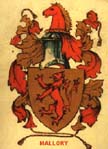 |
Recommended reading for further
information on the mallory family
"History of the Mallory family"
by S V Mallory Smith published by Phillimere Co Ltd.
Also an excellent site to check
out.
Senior Medieval Mallory family
- Genealogy.com
http://www.genealogy.com/forum/surnames/topics/mallory/2742/
by Hiukaru Kilabayoshi
|

|
The
Abbey & Convent of St. Mary of the Meadow was founded in 1143
by Robert le Bossu, Earl of Leicester. The Abbey stood to the
North of the city, outside of the then boundary wall. Administration
of the Manor of Kirkby Mallory was taken over in 1361 by the Abbot,
William of Clown (elected 1345 died 1378). The abbey retained
control for the next 176 years until 1537, being the time that
King Henry VIII dissolved the Monasteries. A year later in 1538
King Henry`s army upon entering Leicester, completely destroyed
the Abbey, their enthusiasm was such that not a stone was left
standing above ground.
 |
It
was not until 1920 that excavation work began to reveal the foundation
stones that are now visible today, as shown in the picture, left
, but this is only a part of the unearthed Abbey foundations.
This stonework can now be seen on the outer edge of Abbey Park
which is located about a mile from the city centre. It must have
been a truly impressive building in its day and reputed to have
been one of the richest in England.
|
After the
destruction of the Abbey, its wealth and lands were duly confiscated
by the crown. And so it was throughout the land that Henry through
his chief minister Thomas Cromwell, proceeded to vent his anger
upon the church seeking revenge after the Pope had refused to
annul his marriage with Catherine of Aragon.
KING RICHARD III, 1485 ...It is probable that King Richard passed though
Kirkby Mallory on his way to confront the army of Henry Tudor,
though his exact route is hotly contended. This historic battle
was to become known as the" Battle of Bosworth" and
was the final engagement in the War of the Roses. On the 22nd
of August, Richard was defeated and killed. The battlefield at
Redmoor Plain lay some 2 miles South of Market Bosworth and the
old Roman road, which ran through the villages of Kirkby Mallory
and Peckleton would certainly have been the most direct route
back into Leicester to where Richard`s body was finally taken.
For the inhabitants of Kirkby Mallory those few days would have
been quite traumatic particularly after the battle with soldiers,
either escaping or celebrating, depending upon which side they
fought would have dispersed through these nearby settlements.
Plaque at Battlefield site denoting spot where
Richard was killed.
Site walk and Visitors
Centre open to public
www.boswothbattlefield.com
|
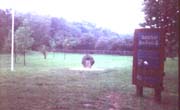 |
KING HENRY VIII
In 1541 after the dissolution of the monasteries King Henry
VIII granted the Lordship of Kirkby Mallory to Thomas Harvey,
an already wealthy land owner. His estates at that time included
lands at Elmsthorpe, Fleckney, Barwell and Hinckley which together
with that of Kirkby Mallory added up to almost 4,000 acres.
The text describes his holdings as being a 1000 acres of land,
500 of meadow, 1000 pasture, 200 wood, 1000
furze and heath and with respect to Kirkby Mallory it also
included about 30 Homesteads. However in 1544, three years after
acquiring the Kirkby Mallory Manor, Thomas Harvey died, and was
buried in the nearby village of Peckleton, which would infer that
this was his place of residence at the time.
Following
his death in1544 and then of his wife's in 1553 his estates and
lands were divided between his co -heirs, being his surviving
daughters, and a granddaughter named Anne Fowler, then aged 14.
(Anne's mother Barbra had married John Fowler of Wellsborough),
Anne subsequently went on to inherited the Manor of Kirkby Mallory.
She later married John Noel, son of Andrew Noel, Earl of Gainsborough.
This was to be the beginning of the Noel association
with Kirkby Mallory which was to last some 370 years
In
1564 it was recorded, there were then 25 families living
in Kirkby Mallory.
Another
influential family living at Kirkby Mallory at this time was the
Dilke family. In 1569 or thereabouts a legal dispute
arose between certain local landowners and the Master and Chaplains
of the Hospital of St. Dewes in Northampton, (plaintiffs). The
landowners (defendants) being, John Harrington Knt, Lord
Harrington of Extan county of Rutland, Sir Thomas Dilke
Knt. George Dilke Gent, and William Roberts.
The dispute was over ownership and lease of lands
in Kirkby Mallory originally endowed by Queen Mary to the above
Hospital. The house and land in question, known as the Beckefield
Pasture ( The Becks), lay to the North of the village. The dispute
continued for several years before finally being put before the
"Barons and The court of Exchequer."the outcome of their
judgment, in part is shown below.
By the records of Hilary term
1570 13 Eliz. Rot 706 Brownlow
.......That
James Harrington Knt. was seized 1/4 part of the Manor.
John Noel Esq. and Wife Anne of another 1/4 part and
Richard and George Dilke 1/4 part each. ......The
court ordered and adjudged that the defendants William Roberts
and George Dilke, and their heirs shall forever hereafter occupy
and enjoy the said lands and premises......... etc.
A point of interest ........ James Harrington also owned the nearby 2,000
acre Bagworth Park, bought from Lord William Hasting`s son. Lord
Hastings commissioned the building of the Ashby and Kirby Muxlow
Castles. He was however executed for treason before Kirby Muxlow
Castle could be completed.
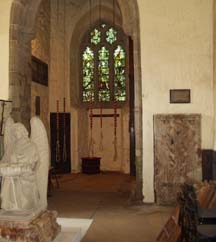 |
Richard Dilke died
at Kirkby Mallory on the 13th Feb 1595, leaving his 1/4 share
of the Manor to his eldest son George. A memorial stone dedicated
to Richard Dilke ( originally a floor stone) may be seen inside
Kirkby Mallory church against the West wall to the right of the
Belfry, ( see photograph, left ). The inscription reads as follows.-
"Here lyeth the bodies
of Richard Dilke of Kirkbye Malorie and Ann his 1st. wife who
had issue 3 sons
and 1 daughter and
Elizabeth 2nd wife who had issue 2 sons and 7 daughters. Richard
died 13th day Feb. Anno Dom 1595
|
Leicester Probate Registry. Will
of Richard Dilke. Inquisition 23rd Aug. 1595
Below
is an abridged version of Richards Dilks Will. For the full text
click here  To be buried at Kirkby Mallory.
To leave to wife Elizabeth either, £200 in goods and
money or else a farm worth £5 by the year and £100
in goods and chattels. My said wife shall live in my
now dwelling house for the 1st. year after my death with
allowance after £5 per year. To George Dilke eldest
son, the indenture and lease of the Manor House of Kirkby Mallory
granted by John the Abbot of the now dissolved monastery unto
Thomas Dilke my farther, dated 10th. July 26 Henry VIII 1534 for
81 years. William my second son to be my executor and to receive
£600 according to an indenture dated 28 Sept. 33 Elizabeth
1591.
To be buried at Kirkby Mallory.
To leave to wife Elizabeth either, £200 in goods and
money or else a farm worth £5 by the year and £100
in goods and chattels. My said wife shall live in my
now dwelling house for the 1st. year after my death with
allowance after £5 per year. To George Dilke eldest
son, the indenture and lease of the Manor House of Kirkby Mallory
granted by John the Abbot of the now dissolved monastery unto
Thomas Dilke my farther, dated 10th. July 26 Henry VIII 1534 for
81 years. William my second son to be my executor and to receive
£600 according to an indenture dated 28 Sept. 33 Elizabeth
1591.
"John the Abbot"
was almost certainly John Bourchier elected 1534 surrendered 1538.
Thomas Dilke, the father of Richard,
was a yeoman who farmed the manor of Kirkby Mallory on a lease,
taken out in 1534 from the Abbey of St Mary of the Meadow, Leicester.
By the provisions stated in the lease Thomas Dilke was obliged
to provide for the upkeep of all buildings outside of the Manor
House and its attached premises, while the Abbey remained responsible
for the Manor house itself and all the heavy timbers therein
used for its support .......
Ref. E 303/ Leic 216 Valor Eccl
(Rec.com) iv 148
It would appear from the provisions
set out in Richard Dilkes Will, that the State honoured the lease
agreement after the dissolution of the monasteries in 1538.
Trying
to identify prominent houses of the time, based on the information
given in Richard`s Will, is difficult, for instance, could the
"Manor House of Kirkby Mallory,"and the property
referred to as "my now dwelling house" be considered
the same property ? I think unlikely. George Dilke was obviously
a very wealthy man, so his dwelling house would have been quite
substantial. The Noel family also had considerable wealth with
Anne Fowler inheriting the "Lordship of Kirkby Mallory"
together with several other estates from Thomas Harvey.
John
Noel (husband of Anne Fowler) had died in 1593 . We know that
Sir Verney Noel was living at the Hall in 1666 from the Hearth
Tax returns. So we could speculate on the sites for these three
notable houses thus.
1. The fortified manor house
known as "The Moats" I am sure would have been (The
Manor House of Kirkby Mallory)
2. The
original "Kirkby Hall " was certainly the residence
of John and Anne Noel
3. Then lastly
the residence of George Dilk, "My now dwelling house",
could this have been the old Manor Farm?. This building is
a good candidate as it was situated in the centre of the old village,
of course there are other possibilities, perhaps the farm at the
Beckfield Pastures to the North of the village as mentioned earlier.
The following document dated 1606,
serves to illustrate, to some extent, the content and acreage
of the estate at that time.
Fine.
Quindene of Easter 4 James I 1606. Between
Thomas Glover Knt and wife Jane, (plaintiffs) and George Dilke
Gent. and wife Ann (defendants) of 3 parts of the Manor
of Kirkbie Malorye and 20 messuages, 6 cottages, 6
tofts, 3 Mills, 30 gardens, 500 acres of land, 200
meadow, 800 pasture, 60 wood, 200 furze &
heath divided into four parts in Kirkbie Malorye and the
advowson of the church divided into four parts .............Right
of Thomas Glover, and the plaintiff gave the defendant £400.
Note
" Fine" in this context refers to a contract
or sale.
"advowson" The right to appoint or recommend
a member of clergy.
The above text, records a sale
in which George Dilk sold land and property to Thomas Glover for
£400 within the Manor of Kirkby Mallory
George`s
father and stepmother had recently died 1595 and 1603 respectively,
so this sale would now make him a very rich man, a millionaire
by todays standard.
Finally,
part of the inquisition on William Noel eldest son of John and
Anne Noel
Inquision. pm William Noel esq.
SeriesII 703-62 taken at Leicester on
18 Jan 18 Charles I 1643 The Jury say that William
died Seised in demesne (possession) as of fee of the whole
Manor or Lordship of Kirkby Malory and the advowson and free disposition
of the Rectory and Parish Church of Kirkby Malory and also the
whole Manor of Wellsburgh ( names of fields given ) ........... William
Noel died 15 March 17 Charles I at Kirkby Malory.1642
Here we find the first reference
to the village Rectory. It is worth noting at this point that
the designated "Lord of the Manor" did not necessarily
own the manor as such, but administered it. He would collect taxes
where appropriate, and dispense justice through the Court Leet
/ Court Baron system as devolved from the Crown and granted
to the Kirkby Mallory estate. By way of this grant, the Lord of
the Manor was able to exercised jurisdiction over his tenants
by means of =
1. The Court Leet which heard
criminal offences not punishable by Common Law, then referred
to as the Assizes, this included offences involving sums of money
exceeding 40 Shillings
2.
The Court
Baron who's main business was to note changes in property ownership
and as such the Lord was able to claim payment for such transactions.
In
1771 by act of Parliament, the Manor of Kirkby Mallory
was due to be "Enclosed". This meant that any remaining
open fields and common pastures relied on by the villagers for
sustenance were now to be taken, divided and fenced off. The practice
of enclosure in Leicestershire had in fact begun much earlier,
ref. ( L. A.Parker "Enclosure of Leicestershire"
1485 - 1607) and had peaked between the years 1490
and 1510. Leicester Abbey in about 1530 was enclosing on
a large scale. The above publication makes reference to an incident
in Kirkby Mallory when ...... The
Abbot, John Penny in October 1501 evicted 18 people and laid down
5 ploughs by destroying 3 farms and by enclosing and converting
180 acres of arable land into pasture. .........
Not much compassion shown there then, but no doubt wool was
a more profitable commodity
|
The area described in the
1771 act totalled some 780 acres and came into force on the 10th.
day of October of that year, .
The act however excluded several
Crofts, one being Battling Croft, a 10 acre field which is now
one of "Mallory Parks" car parking areas, see picture
right.
Battling Croft, together with a
cottage in the tenure of Thomas Cooper, plus a further 106 acres
of land, all belonging to the Parish Church were exempt from
the above act.
|
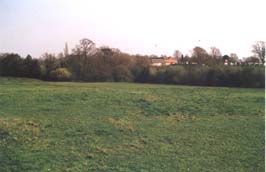 |
 |
LEFT
Showing Boundary
Map of the Kirkby Mallory Manor estate, outlined in red, giving
approximate position of the Open Fields
|
The "Open fields"referred
to in the act, being the subject of the enclosure, were the Beckfield
Pastures to the North, the Long
Sich in the East and Netherfield to the South of the village.
The Long Sich and Netherfield formed an area of land that loosely
followed the line of the Peckleton Brook, and extended to the
South as far as the water course of the Shilton Road brook. This
same brook, who`s source lies to the North in the village of Brascote
was also used to define the Western boundary between the neighbouring
Manors of Barwell, Stapleton and Cadeby. The Long
Sich field contained about 144 acres, this being contiguous to
a homestead belonging to the church, (possibly the now Glebe Farm
on the Shilton Road). The Church Records for 1772 when identifying
family locations, other than "Village Street", make
reference to areas then known as "The Pasture" and "The
Heath".This Act caused great upheaval to the villagers and
their way of life. The Rev. Rowney Noel Rector of Kirkby Mallory
and Edward, Lord Viscount Wentworth "Lord of the Manor",
were both subject of the above act. After the Land Commissioners
had completed their task of dividing and allocating the areas
concerned, the "enclosed" sections they left behind
are the fields of the countryside that we now see today.
|
For the full
text of the Kirkby Mallory Enclosure Act
click here
|
By 1801 there were 49 families living
in the village making up a population of some 243. There was 47
inhabited houses and 3 uninhabited houses. Of those in employment,
15 were in agriculture the other 90 being in trade and manufacturing,
possibly Framework Knitters. The knitters housed their frames,
which they rented, in their own homes. With high rents, unpredictable
trade and exploitation, poverty for these workers was rife.
The village changed little over the following
century. In 1871 there were 56 houses / cottages with 220 inhabitants.
THE RECTORY dates
back to the early 17th century ( mentioned in 1643 ) ,then being
a Half timbered building .The Historian, J.Nichols states that
the rectory was rebuilt by the Rev Clobery Noel, then altered
and enlarged in the 18th century by his successor the Rev.Rowney
Noel . The 1881 census gives us some idea of the Domestic staff
considered necessary for the upkeep of the Rectory. These being
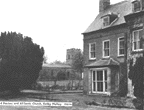 |
Ann Rowly...............Cook,
Hannah Eagleton .....Ladies
Maid
Harriet
Wood ..........House Maid,
Sarah Lasitarn......... Parlour
Maid
Mary
Newcombe.....Kitchen Maid,
George Gibson.........Groom
John
Kerrison..........Gardener
|
The last Rector in residence
was Edgar Mills from 1933 to 1947. ( who conducted my Christening
service). After his retirement the Rectory stood empty for
a time before being finally sold. The following Rector, the Rev
G. Chippington took up his residence at the Peckleton Rectory.
The old Kirkby Rectory was recently demolished due to extensive
decay, but has now been totally rebuilt to a much grander design
and is now in private hands.
ALL SAINTS CHURCH
KIRKBY MALLORY
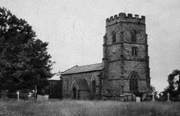 |
Left view taken in 1950
Right view taken, 1999
|
 |
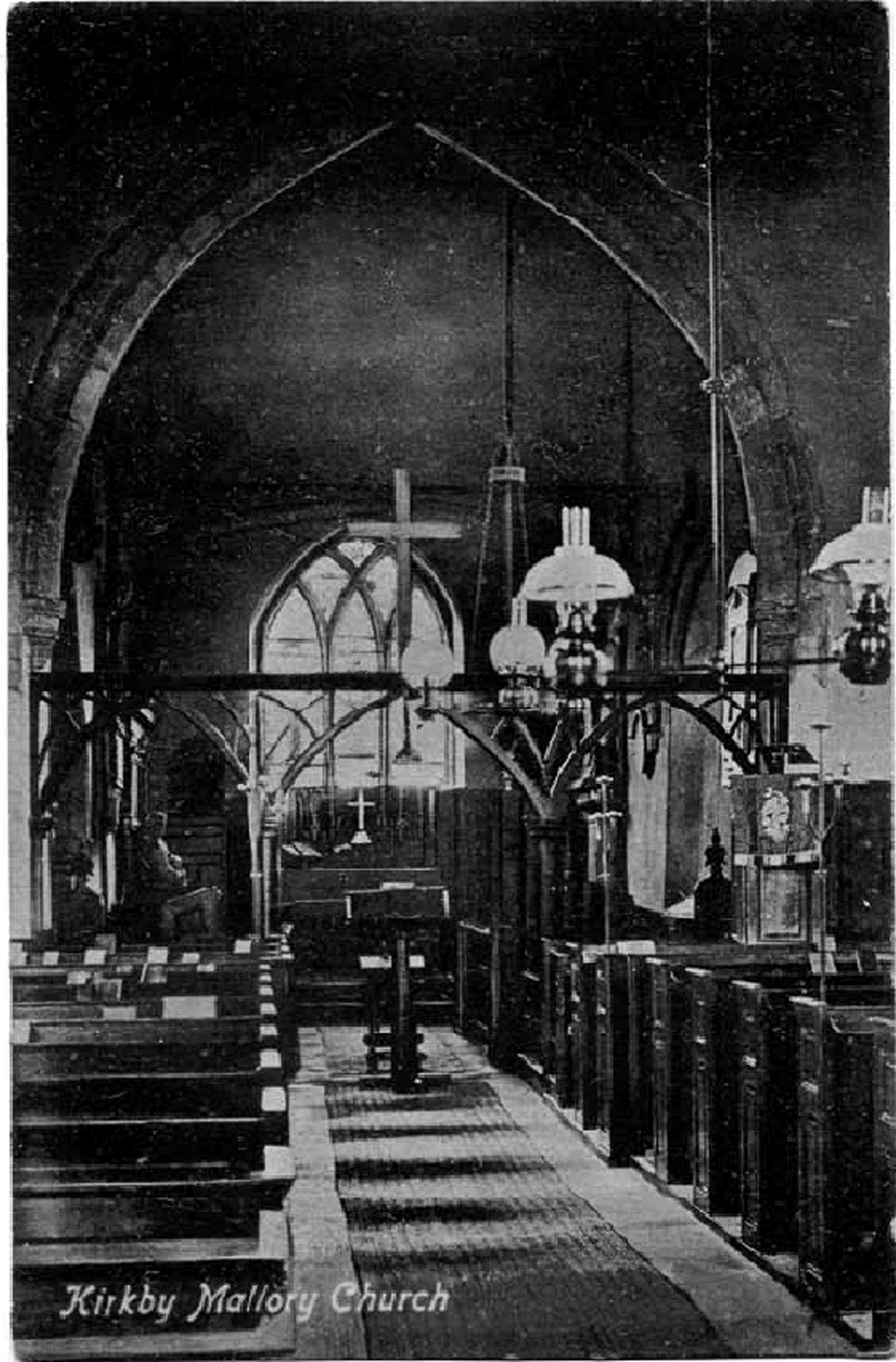 |
Inside All Saints Church Kirkby
Mallory
Photo left circa 1920 Photo below
2016
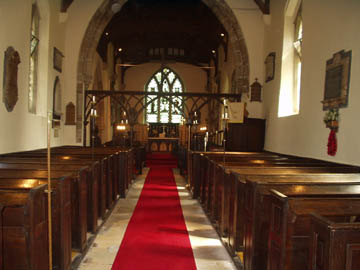
|
The
following paragraph taken from the detailed booklet The church
and Parish of Kikby Mallory by Dorothy Fox.
The Village Church dates back to the
early 13th century. The choir stalls are Jacobean, the rectors
stall is early 17th century and the wrought iron work for the
communion rail has been dated 1615 A new ball and vane was
erected on the tower cupola in 1799. The church organ was acquired
and installed in 1878. Later in 1888 work began on a major refurbishment
program which was to cost some £800. This involved building
a new chamber on the North side of the church to rehouse the organ,
on redesigning the West arch and window, and also carrying out
repairs to the nave roof.
The Bell Tower contains
6 bells, the earlier 3 bells are possibly 16th century. The 4th
and 5th bells were installed to commemorate the dead of World
War 1 and were made in Loughborough. The 6th bell the Tenor was
installed in memory of the Rev.Octavius Philpot who died in 1933.
On the
5th of June 1939 following a meeting between the Church Wardens,
being Mr Alec Summers and Mr A.E. Birch together with other parishioners
and the Rev. Edgar Mills. A unanimous decision was taken to partition
the Bishop of Leicester that "The Electric Light be installed"
within the church. The Leicestershire & Warwick Electric Power
Company had recently brought electricity into the village, so
taking advantage of this new energy source with its labour saving
advantages would have been quite a priority. With permission granted
the contract was eventually awarded to .......... Messrs T.H.
Wathes & Co, Electrical Engineers, Leicester.
The
church organ of course relied upon a continuous supply of air
for its operation, and originally this was supplied by a hand
operated bellows pump at the rear of the organ. On brief occasions
I was able to accompany my uncle, (Frank Heath), who had volunteered
his services at that time (the late 1940's) to attend the daily
services and operate this hand pump during the hymn singing. However
it was not until 1950 or thereabouts that the organ was eventually
converted to operate via the aid of an electric fan.
The
tower clock was donated by the Newton family and was installed
in 1927.
A survey
of the church roof carried out in the late 1960`s had revealed
extensive decay due to infestation and damp. Consequently in 1969
work began to completely replace the church roof. This major undertaking
was duly completed by the end of the following year. Normal church
services, which had been transferred to the School Room, could
now be resumed once again in the church.
 |
|
The
Christmas Nativity play held in the church and performed by the
villagers
My uncle, Joe Heath
is second from left and my mother is fourth from left.
Circa 1962
|
The "Church of England" Village
school was built in 1863, on a site provided by Lady Byron,
the previous school building being on the North side of the village.
In the 1871 census, the School Mistress is given as Elizabeth
Newton aged 29 who originated from Ashby. Ten years later, there
is a new School Mistress named Mary Rowland, who together with
her mother Ann Rowland live at the School House, both originated
from Shropshire. By 1900 there were 90 children on the school
register, but the school had only an average attendance of 30.
At the height of the first World War there were 56 pupils in attendance.
However In 1968 the school was finally
closed and is now used as the Village Hall.
To see past school group photographs click here  ---------------------------------------------------------------------------------------------------------------------------------
---------------------------------------------------------------------------------------------------------------------------------
 Many Thanks to Hazel Handford for
sending in this photograph, taken outside the "Kirkby Mallory
Post and Telegraph Office". The Post Office was opened in
1903 and was then housed in the Blacksmiths Cottage . (see below). Hazel goes on to say that
the bearded gentleman in the driving seat of the coach is that
of Arthur Herbert together with his family. The couple shown against
the fence are Alice Talbot and her daughter Elsie. The picture
(dated pre 1917) was taken by Parker Herbert who had opened a
photographic studio in Barwell.
Many Thanks to Hazel Handford for
sending in this photograph, taken outside the "Kirkby Mallory
Post and Telegraph Office". The Post Office was opened in
1903 and was then housed in the Blacksmiths Cottage . (see below). Hazel goes on to say that
the bearded gentleman in the driving seat of the coach is that
of Arthur Herbert together with his family. The couple shown against
the fence are Alice Talbot and her daughter Elsie. The picture
(dated pre 1917) was taken by Parker Herbert who had opened a
photographic studio in Barwell.
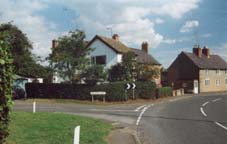 |
The blacksmiths
cottage / Post Office
The census returns for 1881 /
91 gives us some insight into the village community, for instance
the village had a blacksmiths shop, the cottage on the corner
of Desford Lane (see above photo) . This was once thatched, but
now much modernised and extended, and is shown again pictured
left. In the same location, moving to the right in the picture
is the cottage known as "Atlasta"this was reputed to
have been an old Coaching House standing conveniently as it did
next to the Roe Buck
Inn, pictured below |
There were two Blacksmiths listed, Charles Rowley and
Robert Hassell the latter also being the Parish Clerk. Sarah Gibson
kept a grocery shop . Anna Hill was also listed as a Shopkeeper
. The local carpenter was William Bonsir, other occupations to
be found were Thomas Edwards... Butler, unemployed, William Gibson...Groom,
Stephen Pool...Sheppard and William Matkin was a Provisions Dealer
living at Gardeners Cottage (North Lodge?).
Porters Lodge (near Church Walk)
and Keepers Cottage (The Gamekeepers house, Barwell Rd)
together with the Hall were all unoccupied at this time. An interesting
entry is one for a "Steam Cultivator Van in the road leading
to Stapleton". George Tordiff and William Henson,
registered as Lodgers. They must have been contract workers, working
with a steam engine / tractor near the Bridle Road leading to
Stapleton, sometimes referred to as "Dark Lane" due
to the then overhanging trees.
 |
Stapleton
Lane circa 1920,
known locally as
Dark Lane, This lane eventually settled into a cart track when
once past the "Kirkby New Parks Farm" by which time
it had more or less aligned itself with the old Roman road again
Picture shows Hill Farm House in
the foreground.Rose Cottage in the distance
|
|
 |
Village Shop Main Street, Circa
1880
Sarah Gibson`s shop , the sign
over the door reads "Sarah Gibson Dealer in Tobacco"
The 1871 census has her in residence
as shop keeper along with her father
This shop in Church Street was
later to become the Post Office and general stores and was the
home of Miss Molly and Mable Vann during the nineteen fifties
and sixties The 1871 census
I am greatly indebted to Mrs
J. Martin, U.S.A. for her help and supply of photographs in respect
of the Gibson family of Kirkby Mallory.
|
| |
|
The earlier 1861
census gives John Geary (born in Groby) as the Gamekeeper living
at Keepers House . Later in 1871 Colin Vann had taken over as
estate gamekeeper, George Ellis was Head Gardener at the Hall
,and Thomas Beck was " Vintner " at the Roe Buck Inn,
the white house on the corner of Peckleton Road . By the time
of the following census was taken 1881 John Cahill with his wife
Elizabeth had taken over the tenancy of the Roe Buck Inn
|
The Roe Buck Inn
/ Off licence.....
The White House pictured right on
the corner of Peckleton lane
|
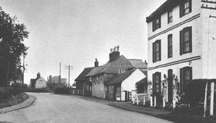 |
Continuing with the 1891 census,
Manor Farm now gets its first mention, although an earlier 1785
map shows buildings there. It is farmed by Joseph Bonsor (born
at Kirkby Mallory). and Mr. Albert Ward is farming at the Glebe
Farm on the Shilton Road.
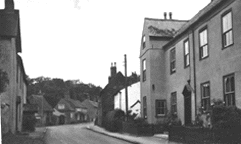 |
Kirkby
House Farm is to the right in this photograph. The 1891 census
tells us that this
is the home of tenant farmer Timothy Summers, and gives his
place of birth as Sutton Cheney, (a small village about six miles
away). He lived there with his wife Sarah and family being,
Tim, Lucy, Charles, Sarah, Frances, Rose and Arthur together
with their Governess, Edith Stevens. Also there are three servants,
Sarah Miller, Frank Cope and John Preston. Timothy's son, also
named Timothy ("Tim"), later went on to farm at Hill
Farm in Stapleton Lane up until the early 1950's |
One of the most striking things
about the entries in the Census Returns for this era is the distance
individuals and families were prepared to travel in order to find
work. I find this quite remarkable considering the basic means
of transport and the limited means of communication, Possible
vacancies would have been advertised through newspapers etc, but
no doubt "word of mouth"would also have played a major
part. The telephone, that we now take so much for granted was
not widely available, not really until the early 1900`s,
and the motor car likewise had yet to make its mark. So
long distance travel relied mainly on the railway network. Yet
in a small village like Kirkby Mallory we find the "place
of origin" listed in the census as being as far apart as
Leeds, Northumberland, Shrewsbury, Charmouth in Dorset,
and Ireland. Then others were employed from less distant
villages from within the county, namely Carlton, Shenton, Stoke
Golding and Wolvey. These journeys could not have been easy, many
taken on unmade roads with horse and cart.
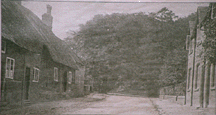 |
THATCHED COTTAGES late
19th. century, long since demolished on the left, that stood
in Church Road opposite the house that was later to become the Village
Post Office in the1940`s. The road shown here provided access
to Kirkby Hall, which lay behind the
trees, and also to the Rectory, turn left in front of the beech
tree .
|
click here for painting  see more detail see more detail |
|
THE ESTATE. Up until the early 1920's the village
cottages and the surrounding farms were all owned by the Kirkby
Hall Estate. In 1921 the village was put up for sale,
The tenant
farmers and villagers were now to be given the opportunity to
purchase their own homes, the Manor was to be split up and sold
off.
AMENITIES in the late 1940`s
and 50`s, I
well remember when growing up
The
Post Office and general stores in Church Road, was kept by two
sisters, Molly
and Mable Vann. Mrs
Biddles owned the Garage, which provided a taxi service, sold
Esso petrol and carried out minor repairs. The nearest cinema
was in Station Road, Earl Shilton which was about two miles away,
so within easy cycling distance. The small field in the centre
of the village known as the "Leas"(meaning grassy
meadow), accommodated the Village Cricket Club. The village
had its own "road sweeper" Mr Jack Parry, employed by
the council, but was not a resident in the village, he lived in
Barwell I believe. Mr. Huntridge was manager at the Hall, and
Mr. Dowler was the gardener there, he lived in Earl
Shilton. Produce from the large garden was on sale to the village.
The Church Wardens were Mr. Alec Summers and Mr.Burch. The Sextant
was Mr.Fred Heath and the church organist was Miss Edith Summers
while Mr. Ben Gibson serviced the church clock.
Mrs Nellie Farmer took over the position as the "live
in" school teacher circa 1956 to 1964
Up until the late 1950`s the community
relied heavily upon traders from outside the village to provide
essential provisions. They would visit weekly or less, some in
dedicated vehicles fitted out for the purpose. Mr. Cooper (from
Leicester) would supply a wide range of hardware and cleaning
material. Mr. J. Weston (from Desford) was the Greengrocer, His
Family owned the grocery shop there for many years. John served
in the R.A.F. during the war. When 18 he served as a rear gunner
in Lancasters, like he later said on his 90th birthday "lucky
to be here".
Then
there was "Archers" (also from Desford) sold cycle parts
and batteries etc., bicycles far out numbered cars so this was
quite a lucrative business at the time. The Baker, Butcher, Grocer
etc. would each have their respective rounds, again visiting as
necessary.
WOMANS GROUPS
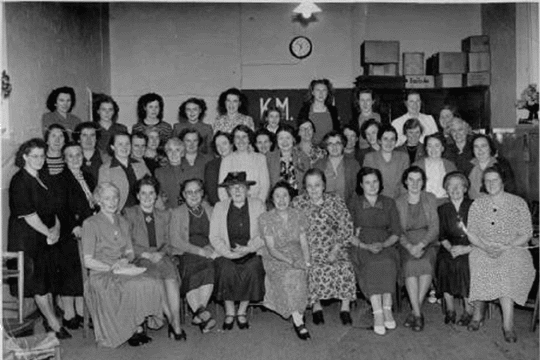 |
Womans institute
1949.
Kirkby Mallory
supported two woman's groups, "The Womans Institute"
founded in 1924 and the "Mothers Union".
Both these groups
being very well attended in the past
 Click here for enlargement, plus names Click here for enlargement, plus names
|
TRANSPORT
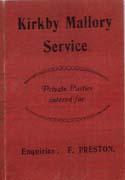 |
 |
Probably the earliest bus service to be operated between
Kirkby Mallory and Leicester (Western Boulevard) was one
provided by Mr. Fred Preston, father of Tom Preston who later
managed the village garage for Mrs Biddle
There is no date
on the card, but it would have been around 1920
Many thanks to Helen Hamer
for the photocopies.
|
A more comprehensive
service was later provided by two bus companies. The
"Comfort"bus company provided a service into Leicester
( last bus 6.00pm.) weekdays , while the second , the "Browns
Blue" bus company provided transport into Hinckley via Earl
Shilton.
For school
transport, the "Deacon & Hardy" company based at
Barleston did the run to South Charnwood Secondary Modern School,
situated about a mile from Markfield, leaving the "Clarence"bus
company to provide a likewise service to the Dixie Grammar School
in Market Bosworth.
|
The
Village Post Office
The Post Office had been accommodated
in various locations throughout its roughly 100 year history.
An early Ordinance & Survey map dated 1903 gives its location
as being at the Roe Buck Inn. However there may of been some
confusion here because there is photographic evidence that it
was actually in the property just a few yards away on the corner
of Desford Lane, adjacent to the Smithy. From there it moved again to the shop
in Church street, adjacent to the school, occupied earlier
in 1871 by Sarah Gibson and her elderly father John. (See
photo above)
The last Post Office in
Kirkby Mallory was kept by Mrs Reed and family who lived in Desford
Lane. When she retired in October 1990 the Office was obliged
to close as no new proprietor could be found. So the closure
and transfer of business to the Earl Shilton Main Office. was
therefore inevitable
|
The document shown
below is a receipt for the conveyance of that property then known
as "The Old Post Office" from the Countess of Lovelace
& Others to Mr.
Edward Gibson  for £120 dated Jan. 1921,
being the time of the estate breakup . The Messuage refered to,
i.e. the Outbuilding, was the Blacksmiths Forge, see photo Re.
Mr. Edward Gibson
for £120 dated Jan. 1921,
being the time of the estate breakup . The Messuage refered to,
i.e. the Outbuilding, was the Blacksmiths Forge, see photo Re.
Mr. Edward Gibson
|
(Copy) Mr
Edward Gibson ...... to
.....
S.H. & W.J. Pilgrim
Jan 1921.......
The professional charges in connection with the conveyance
to you from the Countess of Lovelace & others of a messuage
& premises known as the Old Post Office Kirkby Mallory, the
consideration being £120 including completion in London
£2-15s
Payments
Stamp on conveyance 12s-6d Parchment
paper for conveyance 3s Share of expenses to London
£1-15s
£4-10s-6d
received S.H. Pilgrim
|
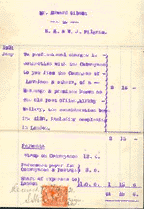 Original invoice
Original invoice
|
Courtesy of Mr Lance Gibson
|
CLICK BELOW FOR MORE PAGES,
VILLAGE MAPS, PHOTOS and CONTRIBUTIONS etc
|
KIRKBY MALLORY REMEMBERED extra
pages
|
Village map circa
1920 |
 |
|
Aerial picture
of village, mid 1950`s |
 |
|
Village photographs,
comparisons between the old and the new |
 |
|
The sites of
the Kirkby Manor Water and Wind Mills |
 |
|
Contributions to the History site, New |
 |
|
School Photographs
1910 to 1952 |
 |
|
|
|
Return to
Index Page |
 |
PLEASE
VISIT AGAIN, RESEARCH CONTINUING ......




















